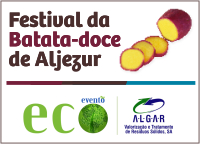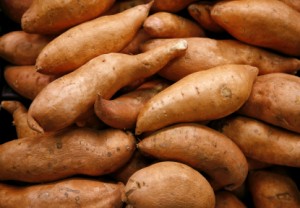The Aljezur Sweet Potato Festival: worth a visit
Each autumn, Aljezur celebrates the sweet potato and its importance to the community by holding a Festival.

The 2011 event ran from Thursday to Sunday, from midday to midnight, except on the Sunday, when it closed at 9 pm. It takes place in the Espaço Multiusos, a vast, one hundred metre long metal shed set among steep wooded hills with views across the valley to the old town and castle.
Aljezur was founded in the tenth century by the Arabs, but in 1249 was taken by a band of knights of the Order of Santiago. They attacked the castle so suddenly that the moors had no time to defend themselves.
Legend has it that, before each battle, these knights would imbibe a potion made from sweet potato. Their exceptional courage and vigour could only be the result of the magic potion. The legend ignores the inconvenient truth that the sweet potato was only introduced to Europe after the discovery of the new world, but it does demonstrate the prominence accorded the humble vegetable in the local culture.
The festival has been running since 1998. The sweet potato (batata doce) originally shared its billing with another regional delicacy, the Goose Barnacle (perceve), but these days it’s all about that traditional staple of local subsistence farming, the sugary spud.
Currently produced by around 300 growers, the Aljezur sweet potato is differentiated by its purple to brown skin, its white interior and special flavour. Due to the unique climatic and soil conditions, it is sweeter and less fibrous than other varieties. Under the superficial sandy soil layer lies a well-compacted stratum of clay and bark, which retains the water, helping the tubers to develop.
The Aljezur sweet potato was finally recognised by the European Commission in 2009 as worthy of its own IGP seal (Indicação Geográfica Protegida), denoting a product from a protected geographical area.

Here you can sit down at any one of a dozen eating places under the auspices of Saberes e Sabores Vicentinos and enjoy more ways of eating the sweet potato than you can shake a fork at, all washed down with carafes of local plonk.
On show is an intriguing variety of local handicrafts, food and beverage products. You can buy sweet potatoes direct from the growers, meet organisations like Almargem, the Igreja Evangélica or the Escola Internacional, and watch cookery displays, music and dance performances.
The local worthies are out in force: roly-poly chaps with flat caps and fleeces, coiffured matrons in their Sunday best and all manner of eccentric estrangeiros. The cavernous Espaço Multiuso echoes with clattering plates, clinking glasses, booming announcements and the chattering crowd.
We arrived hungry at half past three, and made a beeline for “A Lareira”, normally one of Aljezur’s more reliable restaurants. In the spirit of the event, I ordered the “Prova de Sabores de Batata Doce das 7 Maravilhas de Gastronomia” ( 10€), and some Algarvian red.
The “seven gastronomic marvels” turned out to be sweet potatoes in their jackets cut two ways, sweet potato chips, sardines, deep-fried pork scratchings and a tomato sauce dip. That’s six marvels max and, whether it was the hour or the limitations of the field kitchen, the food was cold.
My daughter fared better with Ameijoas (clams) and my wife ordered the Leitão (suckling pig), which she said was OK. The dessert menu featured “Tarte de Batata Doce especial de Lareira”, “Pasteis de Batata Doce”, “Bolo de Batata Doce com Amêndoa” and more on the same theme, but we’d lost our appetite.
I was reminded of the previous year when we chose the “Associação dos Pescadores do Portinho da Arrifana”. You would expect fishermen to serve up a decent fish, but after ordering the sea bass we were disappointed to discover that it was mostly head. They must have sold off the rest at market. The Portuguese will tell you that the head is the best part, but not when it’s the only part.
We had better luck browsing the craft and produce stalls. On offer were walking canes, mirrors and giant spooky masks made from cork and other local woods, miniature carts of various sizes, woven baskets and lots of jewellery and trinkets.
Food and drink included fresh bread and cakes from the bakeries of Monchique and Rogil, hams and sausages from Monchique, medronho (the local firewater, a 50% proof liquor made from the fruit of the strawberry tree), rosemary, orange blossom and even medronheira honeys, and those quintessentially local delicacies, Borley’s Pies (seriously, the factory is in Aljezur).
On show outside were tractors from two incongruous names. Branson isn’t another airline or even bank, but the Western distribution arm of a South Korean company. And the sleek, stylish Lamborghinis were anything but supercars. Evidently tractors were a big part of Ferrucio Lamborghini’s empire until 1972, when a financial crisis forced him to sell the unit out to SAME, a different Italian tractor maker.
If you arrive early you will probably have better luck with the cuisine, otherwise definitely worth a visit.
Al Garvey
Notes on sweet potato production
Preparation of the soil starts with harrowing, followed by the mixing in of locally sourced organic manure.
Cultivation starts in February in the nursery by burying tubers from the previous harvest to a depth of 10 to 15 cm. By the end of April, these tubers have produced vegetation and are then transplanted with about 25 cm of the stem (poda) to the final growing area. Each kilo of tubers planted in February yields around 200 podas.
The transplantation is normally by hand, and is followed by one or two weedings to ensure that the sweet potatoes dominate the growing area. Regular irrigation is not normally necessary, unless the particular soil has poor water retention. Harvesting takes place when the tubers reach maturity and when the soil is not too humid. This can happen between mid-September and mid-November, although mid-October is best, as an early or late harvest can have a negative effect on quality.
The harvest is then “cured” by surrounding it with soil for about eight days, while the nights are still not too cold. This enables cuts and other damage to heal. The sweet potatoes are then cleaned and ideally stored in a dry, airy location under cover.
To maintain the high standards necessary for commercialisation, the final selection and conditioning of the product can only take place in the region of origin and in facilities authorised by the Growers’ Association.
2 Responses to “The Aljezur Sweet Potato Festival: worth a visit”
Leave a Reply




Malang Baba on January 3rd, 2012
Eating lunch at half past three. You deserve all you get!
donaldo on September 30th, 2015
Tried Aljezur sweet pots for first time in Figuera 2015 – wonderful earthy flavour. I need to buy them here in UK .. but how ???